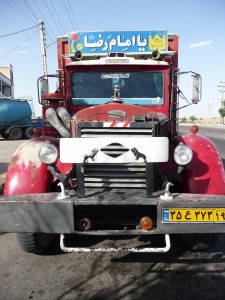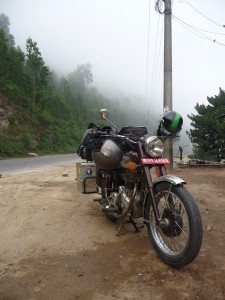Riding through the hills around Kaleybar, in South Azerbayjan in the north of Iran, the hole-in-the-head-problem had clearly returned. The weld in the engine head, done in Tehran just a few weeks ago, had holes in various places. Uphill the bike was wheezing like an asthmatic donkey and demonstrated matching torque – a great way to burn a set of clutch plates. Starting was next to impossible, the engine simply didn’t have enough compression. Fortunately my new friend Masoud, taxi driver and tour guide, knew a mechanic in Abdel Razaq, 50 kilometres down the road to Jolfa, who would certainly be able to solve my problem.
The road was beautiful. Not much traffic, so I puffed my way through rolling hills and rocky mountains unbothered. I managed to attach the camera to my tankbag – a move of debatable merit as the video portrays me as a geriatric cripple who’s afraid of everything that is not flat and straight. You lose the joy of riding a little if anything that requires a bit of pick-up has to be done in first gear.
the road between kaleybar and abdel razaq * with original music
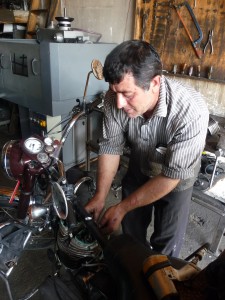
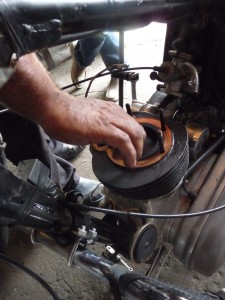
Unfortunately, by the time the engine was in pieces, the electricity was gone. A mysterious phone call promised its return at 3 pm. It was 11:30 in the morning. No problem – my longer-than-planned stay in Kaleybar had eaten my money, so I hitch-hiked the 35 km to the nearest village with a bank. The journey didn’t take long, these people drive like maniacs. In a good way.
In the bank I was of course told they couldn’t change money, I’d have to go to Tabriz, a day’s travel away. I just hung out a bit, while more and more people gathered. Eventually I got what I needed, at an incredible exchange rate.
Sitting in the shade of a tree eating a lunch of bad crisps and worse cakes, I realised once again how happy I was, how easy everything actually was, or rather how perfectly allright. And how special. Now all I need to do is find out how to bring this attitude to bargaining with rickshaw drivers, asking directions, and thinking about my future.
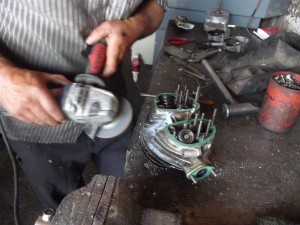
When everything was done, I started the engine with a satisfying roar and took off, waved goodbye by an enormous crowd of well-wishers that had materialised over the previous fifteen minutes. From 0 to 90 km/h in 100 metres! Or so it seemed. I don’t think the bike ever performed that well, except maybe in the Golden Days of Highway 76 in Rajasthan, last November, on my trip from Nepal to South India. Another reminder of those days were the herds of cows and goats on their way home.
I turned left when I met the Aras river, at Eskanlu, the golden late afternoon light casting my shadow ahead of me. The river, which forms the border with Azerbayjan and, later on, Armenia, grew to the width of a small lake while I was in a tunnel, and kept changing appearance after that. I was surprised how fast it flows.
Empty villages on the north bank in war-stricken Azerbayjan curiously fit in the landscape, as did the rusty barbed wire fence that lined long sections of the river.
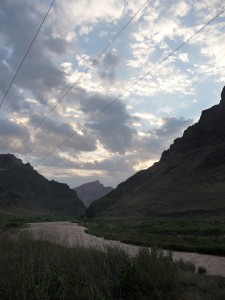
Another reason not to stop was that the beauty of the sky also indicated the coming darkness. Coming around a bend a little later, the sky was on fire – and then the sun dropped behind the horizon.
The road, severely damaged in places and covered with gravel in others, snaked through the mountains and it was very windy. While the sun disappeared, a thunderstorm started. At first, the lightning was horizontal, high up in the sky, then the lines, looking like cracks in an old wall also connected to the ground. No sound of thunder though, so it was far way – at least for now. A sign told me I had 25 kilometres to go, reminding me of how long the 25 km through rain and lightning in Lahore had felt – the cold, the darkness, the slippery road, the fallen trees on the road, the crash. Sometimes the road led to the right of the dark clouds, west toward the bit of light that wasn’t gone yet. At other times, the road aimed straight towards the streaky curtains of rain, making me wonder if I’d get soaked and maybe worse after all. Then, unexpectedly, I rode into a part of Jolfa that reminded me of shopping centres in mid-sized European dormitory towns – lots of square buildings selling poor quality versions of anything you could think of. I easily found the hotel I was looking for, and took my lugguge inside while the clouds burst into big tepid drops and the last light disappeared. I finished the day with two omelets (with tomato, as is the norm) and several cups of tea, chatting with the friendly proprietor and several Balochi Pakistanis that were staying there.

